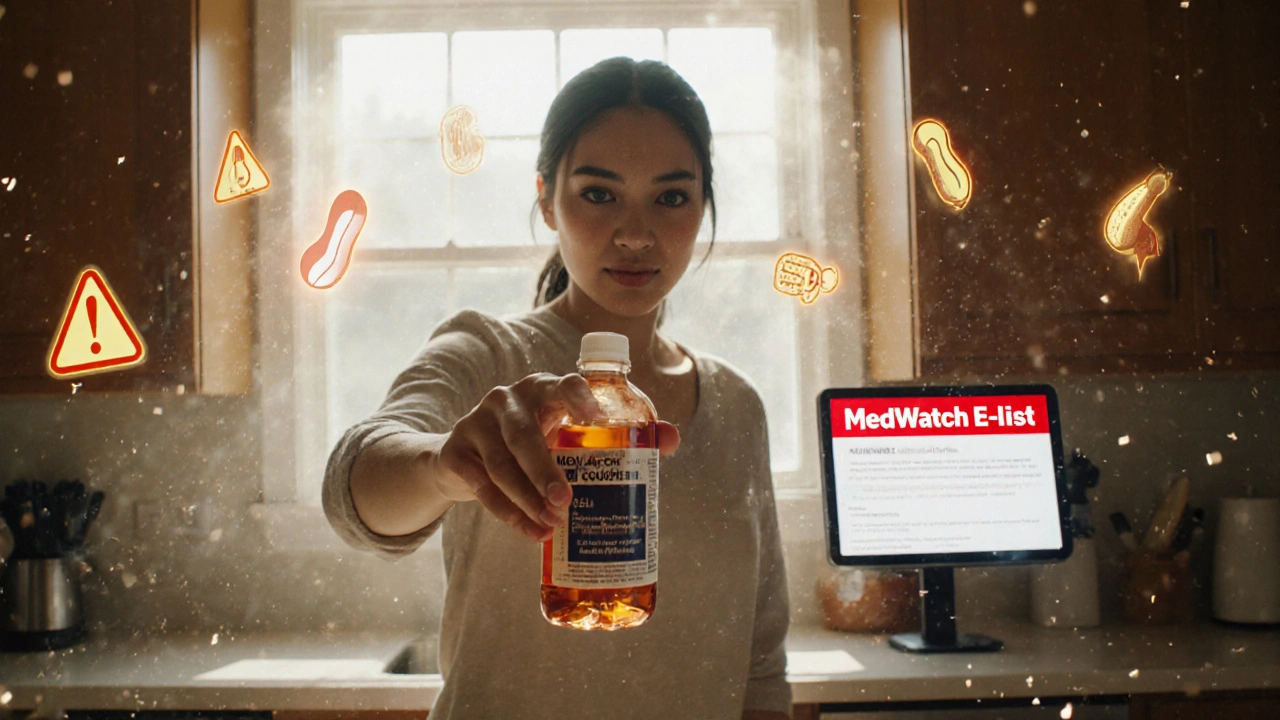Every year, the FDA issues over 1,200 safety alerts about drugs, medical devices, and other regulated products. Some of these alerts mean the difference between taking a safe medication and accidentally using a contaminated or dangerous batch. If you’re a patient, caregiver, pharmacist, or healthcare provider, knowing how to get these alerts in real time isn’t just helpful-it’s essential.
Why You Need FDA Drug Safety Alerts
In 2018, a contamination in valsartan, a common blood pressure medication, led to recalls across multiple brands. Patients didn’t know their pills were unsafe until weeks later. That delay cost lives. Since then, the FDA has overhauled its alert systems to cut response times from days to hours. Today, alerts are sent out within 4.2 hours of a recall being confirmed-much faster than commercial services, which average over 8 hours. The goal is simple: get the right information to the right people before harm happens. Whether it’s a recalled insulin batch, a labeling error on a painkiller, or a new warning about a common antibiotic, these alerts help you make safer choices.The Three FDA Alert Systems You Can Subscribe To
The FDA doesn’t have one single alert system. It runs three separate ones, each with a different purpose. Many people sign up for one-or none-because they don’t know the difference. Enforcement Report Subscription Service is for recalls. If a drug is pulled from shelves because of contamination, mislabeling, or manufacturing defects, this is where you’ll find it first. You can pick categories like “Drugs,” “Medical Devices,” or “Cosmetics,” and set your email to come daily or weekly. Best part? You can add up to five custom keywords. Search for “peanut,” “insulin,” or “metformin,” and you’ll only get alerts about those. This feature, added in July 2022, lets you cut through the noise. MedWatch Safety Alerts covers a broader range of safety issues-not just recalls, but also new warnings, side effects, and product defects. It’s been around since 1993 but got a major upgrade in 2015. You can subscribe via email (MedWatch E-list), Twitter (@FDAMedWatch), or RSS feed. Over 285,000 people follow the Twitter account. It’s fast, free, and widely used by hospitals and pharmacies. Drug Safety Communications is the most targeted. It’s designed for healthcare professionals and patients who want updates on specific drug classes. Got a patient on statins? Subscribe to alerts about cholesterol meds. Worried about antidepressants? Get notified when new risks are found. You sign up directly from the FDA’s Drug Safety Communications page. No keywords here-just topic-based subscriptions.How to Subscribe (Step-by-Step)
You don’t need special software or a login. All three services are free and only require an email address.- For Enforcement Reports: Go to fda.gov/enforcement-report-subscription. Enter your email, select “Drugs” (most common choice), and add up to five keywords like “lisinopril” or “warfarin.” Choose daily or weekly delivery. Click submit.
- For MedWatch E-list: Visit fda.gov/medwatch-email-list. Fill out the form with your name and email. Select the types of alerts you want-drug safety, device issues, or both. Confirm your subscription via the email you’ll receive.
- For Drug Safety Communications: Go to fda.gov/drugs/drug-safety-and-availability/drug-safety-communications. Scroll to the bottom and click “Sign up for email alerts.” Pick the drug categories you care about-antibiotics, diabetes meds, blood thinners-and submit.

What You Won’t Get from FDA Alerts
It’s important to know what these systems don’t do. They won’t send you push notifications on your phone. They won’t tell you if a drug interacts with your other medications. They won’t explain complex side effects in plain language. Commercial services like MedWatcher or First Databank offer those extras-but they cost money. MedWatcher charges $9.99/month. First Databank’s clinical tools run over $1,200 a year for institutions. The FDA’s system doesn’t compete on features. It competes on authority and speed. No other source has the legal power to mandate recalls or update drug labels across the entire U.S. market.Real Impact: Stories from Subscribers
A hospital pharmacist in Ohio told Reddit users that a keyword alert for “insulin” warned her team about a recalled batch. They pulled 120 vials before a single patient received it. A mother with a peanut allergy said her keyword alert for “peanut” stopped her from buying a contaminated over-the-counter cough syrup. These aren’t rare cases-they happen weekly. A 2022 survey by the American Medical Association found that 72% of doctors who received FDA Drug Safety Communications changed how they prescribed based on the alerts. That’s a huge number. It means real people are getting safer care because someone subscribed.Common Problems and How to Fix Them
Not everyone finds these systems easy to use. The biggest complaints? Too many alerts and not enough detail.- Alert overload: If you’re getting too many emails, go back and tighten your keywords. Instead of “drugs,” try “metformin” or “statins.” Reduce frequency from daily to weekly.
- Confusing which system does what: Enforcement Report = recalls. MedWatch = safety warnings and side effects. Drug Safety Communications = specific drug class updates. If you’re unsure, check the FDA’s help page. Their support team responds in under two business days.
- Lack of mobile access: Right now, you can’t get these alerts in a phone app. But the FDA confirmed in October 2024 that a mobile app is in testing and will launch in Q2 2025.

What’s Coming Next
The FDA is making big changes. By late 2025, the three separate alert systems will merge into one unified platform. That means one email, one dashboard, one place to manage everything. They’re also testing machine learning to prioritize alerts-so the most urgent ones (like those linked to deaths or hospitalizations) rise to the top. By December 2025, you’ll be able to set up to ten keywords instead of five. And Spanish-language alerts are coming in Q3 2025 to serve the 22% of U.S. residents who speak Spanish at home.Who Should Subscribe?
If you take prescription drugs, manage medications for someone else, or work in healthcare-you need these alerts. Pharmacists, nurses, doctors, and even caregivers benefit. But patients shouldn’t wait for someone else to act. If you’re on a long-term medication, especially one with known risks (like blood thinners, diabetes drugs, or psychiatric meds), subscribe yourself. The FDA doesn’t notify you when something goes wrong. You have to sign up. And right now, only 38% of healthcare professionals even know all three systems exist. Don’t be part of that 62%.Final Tip: Check Your Alerts Monthly
Set a calendar reminder. Once a month, open your FDA alert emails. See if the topics still matter. Remove keywords you no longer need. Add new ones. Adjust frequency. These systems are powerful-but only if you keep them tuned to your needs. The goal isn’t to be overwhelmed. It’s to be informed. And with the right setup, you can turn FDA alerts into a personal safety net.Are FDA drug safety alerts free?
Yes, all FDA drug safety alert subscriptions are completely free. You only need an email address. There are no hidden fees, no trials, and no premium tiers. The FDA provides these services as part of its public health mission.
What’s the difference between MedWatch and Drug Safety Communications?
MedWatch covers broad safety issues including recalls, side effects, and product defects across all FDA-regulated products. Drug Safety Communications focuses specifically on detailed safety updates about particular drug classes-like new warnings for diabetes medications or risks linked to blood thinners. Use MedWatch for general alerts and Drug Safety Communications for targeted drug-specific updates.
Can I get FDA alerts on my phone?
Not yet, but it’s coming. As of October 2024, the FDA confirmed it’s testing a mobile app that will deliver alerts via push notification. The app is scheduled to launch in Q2 2025. Until then, email is the only official way to receive alerts directly from the FDA.
How often are FDA drug safety alerts sent?
It depends on the service. The Enforcement Report lets you choose daily or weekly emails. MedWatch and Drug Safety Communications send alerts as soon as new information is confirmed-sometimes multiple times a week, sometimes only a few times a month. There’s no fixed schedule; alerts are triggered by actual safety events, not by calendar dates.
Do FDA alerts cover over-the-counter (OTC) drugs?
Yes. The FDA’s alert systems cover all regulated products, including prescription drugs, over-the-counter medications, biologics, and medical devices. If an OTC pain reliever is recalled due to contamination or a new safety warning is issued for an antacid, you’ll get an alert if you’ve subscribed to the “Drugs” category.
What if I miss an alert? Can I look up past ones?
Yes. All past alerts are archived and publicly available. Enforcement Reports are listed at fda.gov/enforcement-reports. MedWatch alerts are at fda.gov/medwatch-safety-alerts. Drug Safety Communications are at fda.gov/drugs/drug-safety-and-availability/drug-safety-communications. You can search by drug name, date, or keyword anytime.
Are FDA alerts available in languages other than English?
Currently, most alerts are only in English. However, the FDA has committed to launching Spanish-language alerts in Q3 2025 as part of its Language Access Plan. This change will help reach over 40 million Spanish-speaking Americans who currently have limited access to critical safety information.
Can I unsubscribe if I change my mind?
Yes. Each alert email includes an unsubscribe link at the bottom. Clicking it will remove you from that specific list. If you subscribed to multiple services, you’ll need to unsubscribe from each one separately. There’s no central account to manage-all subscriptions are independent.
